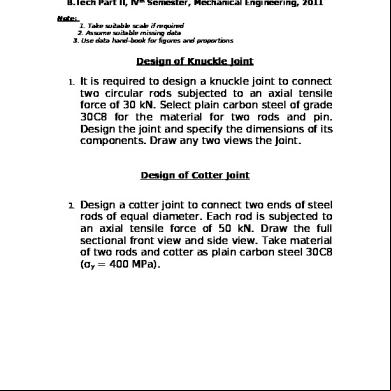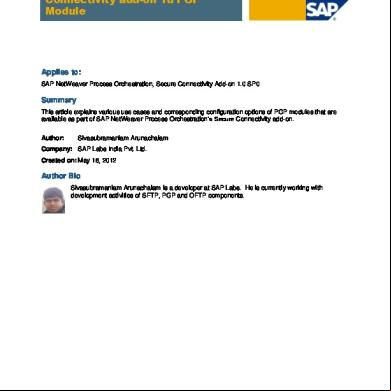Keys Cotter ts 4c635j
This document was ed by and they confirmed that they have the permission to share it. If you are author or own the copyright of this book, please report to us by using this report form. Report 445h4w
Overview 1s532p
& View Keys Cotter ts as PDF for free.
More details 6h715l
- Words: 596
- Pages: 12
[email protected] KEYS, COTTER and TS Keys: - These are temporary fasteners. - Used to hold pulleys, wheels, gears etc on the rotating shafts, such that there is no relative rotary motion between the pairs. - Functions of keys: o It is an agent in transmission of power, motion, torque between the pairs. o It is also used as a safety feature. When overloading occurs, the key will fail before the actual parts. o Keys are easy to replace and costs less. Classification of keys: Depend chiefly upon the load to be transmitted: (1) Heavy duty keys a. Sunk key - A key which goes in the key seat. The key seat is a sort of groove to hold the key. Key seat is machined partly in the shaft and partly in the part ed. - Sunk key is mostly of rectangular or square key. These two can be parallel or taper keys. - Drawing proportions: o Rectangular key: W=0.25D and T=0.66W.
o Square key: T=W.
(b)
W=0.25D
and
Gib head key - Key is provided with a head at one end to facilitate withdrawal of the key.
(c)
Splines - The key is actually the solid integral part of the shaft and corresponding grooves/ keyways are made on the ed parts. - There can be number of keys on the circumference of the shaft.
(2) Light duty keys: a. Flat saddle key.
It is flat on the shaft. As it is liable to slip on shaft, so it is used for light duty.
b.
Hollow saddle keys: - The key is curved to fit on the shaft. - It increases friction.
c.
Round or pin key - It is a circular pin. - It is fitted in a hole drilled partly in the end of a shaft and partly in the ed part.
d.
Woodruff key - It is a segmental disc with a flat or round bottom. - The keyway is also of disc type. - It is an self adjustable key.
COTTERS - These are again the temporary fasteners. - It is a wedge shaped piece of mild steel, tapered on one or both side (1:20-50). - It is tapered so as: o Facilitate the positioning and withdrawing of the cotter. o For lateral adjustment. - Used to hold two parts where the parts are subjected to axial forces only. - Usually driven perpendicular to the axis of the connected parts.
DIFFERENCE BETWEEN KEYS AND COTTERS
- Keys are driven parallel to the axis but cotters perpendicular to axis. - Keys are used where parts are subjected to torque but cotters are used where parts are subjected to tensile or compressive forces. - Keys resist shear over a longitudinal section but cotter resist shear over two transverse sections.
COTTERED TS - ts formed by using a cotter are called cottered ts. (1) Spigot and socket cottered t - Used for round rods.
2. Sleeve and cotter t.
3. Gib and cotter t - used for square rods. - Gib is a piece of mild steel having the same thickness as cotter and is used in combination of cotter.
- Uses of gib: (a) When the cotter is driven in position, it has the tendency to bend the lower part
of the fork end away from rod. It is prevented by using a gib. (b) To increase the bearing area of between the mating parts.
PIN T OR KNUCKLE T - t allows a small angular movement of the rods relative to each other. - t is capable of transmitting rotary and transverse motion.
o Square key: T=W.
(b)
W=0.25D
and
Gib head key - Key is provided with a head at one end to facilitate withdrawal of the key.
(c)
Splines - The key is actually the solid integral part of the shaft and corresponding grooves/ keyways are made on the ed parts. - There can be number of keys on the circumference of the shaft.
(2) Light duty keys: a. Flat saddle key.
It is flat on the shaft. As it is liable to slip on shaft, so it is used for light duty.
b.
Hollow saddle keys: - The key is curved to fit on the shaft. - It increases friction.
c.
Round or pin key - It is a circular pin. - It is fitted in a hole drilled partly in the end of a shaft and partly in the ed part.
d.
Woodruff key - It is a segmental disc with a flat or round bottom. - The keyway is also of disc type. - It is an self adjustable key.
COTTERS - These are again the temporary fasteners. - It is a wedge shaped piece of mild steel, tapered on one or both side (1:20-50). - It is tapered so as: o Facilitate the positioning and withdrawing of the cotter. o For lateral adjustment. - Used to hold two parts where the parts are subjected to axial forces only. - Usually driven perpendicular to the axis of the connected parts.
DIFFERENCE BETWEEN KEYS AND COTTERS
- Keys are driven parallel to the axis but cotters perpendicular to axis. - Keys are used where parts are subjected to torque but cotters are used where parts are subjected to tensile or compressive forces. - Keys resist shear over a longitudinal section but cotter resist shear over two transverse sections.
COTTERED TS - ts formed by using a cotter are called cottered ts. (1) Spigot and socket cottered t - Used for round rods.
2. Sleeve and cotter t.
3. Gib and cotter t - used for square rods. - Gib is a piece of mild steel having the same thickness as cotter and is used in combination of cotter.
- Uses of gib: (a) When the cotter is driven in position, it has the tendency to bend the lower part
of the fork end away from rod. It is prevented by using a gib. (b) To increase the bearing area of between the mating parts.
PIN T OR KNUCKLE T - t allows a small angular movement of the rods relative to each other. - t is capable of transmitting rotary and transverse motion.










